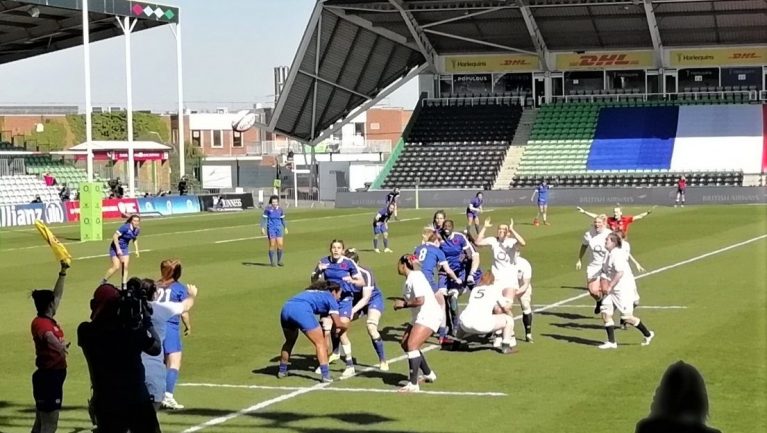Between 10 July 2019 and 30 April 2021 England and France met eight times. They sought each other out to ensure they faced the sternest opposition in the search for perfection.
This autumn saw their policy come to fruition, and they didn’t meet once. Instead, the recurrent world champions came calling. The result of the four-match tour (Europe 166 New Zealand 47) is proof their policy was correct.
The two managements are unlikely to accept my claim, but the two playing styles have grown far more similar.
Here are a few features (purely in alphabetical order): back-three togetherness, centre-types, counter-rucking, driving maul, half-back balance, kicks from hand, line speed, line-out efficiency, No 10s, ruck speed.
Back-three togetherness
The back-threes have long been the show-ponies of the rugby team, but the past year has seen the French and English trios reach new heights of excellence. Abby Dow and Cyrielle Banet vie with each other for the most glamorous tries, Dow winning out purely in terms of distance run; she is making a habit of starting her raids from her own half.
Both sets of wingers go looking for work in midfield and on the opposite side. The full-backs, here Chloé Jacquet, Ellie Kildunne, Émilie Boulard and Sarah McKenna, constantly asked questions of the Black Ferns’ defence, joining attacks where they could do most damage. Portia Woodman was found wanting more than once in her covering.
It’s a comfort to both teams that they know they can keep spreading the ball wide; their back threes are going to profit mightily.
In defence it was noticeable how willing they were to stand firm in Woodman’s path, Jacquet allowing herself to be bowled over backwards as she held on to her powerful opponent.
Centre-types
Imagine a game with Gabrielle Vernier and Maëlle Filopon facing Helena Rowland and Holly Aitchison in the centre. No Scarratt, Reed or Tuima on one side; no Neisen or Marine Ménager on the other. So no battering rams to drive through the middle. Instead, magical running lines and artful handling to bypass the opposition. And the tackling will be as ruthless as anywhere on the park. Vernier stood out for a number of crucial tackles she put in to stem Black Fern attacks.
The counter-ruck
Both nations are turning this element of the game into a fine art. They wait patiently till they spot a weakly established ruck, then exploit. Surprise is the key here, and it saves a lot of energy when you are not trying to oppose every breakdown with full force. The suddenness of the turnover is all the more likely to offer counter-attacking opportunities.
Driving maul
This invaluable part of the game has seen the French improve their technique to match the English. Agathe Sochat now reacts to scoring on the back of a catch-and-drive with the same insouciance as Amy Cokayne and Lark Davies. ‘All in a day’s work’.
It is quite another matter to know how to counter this deadly weapon. The Black Ferns certainly didn’t find the answer on tour.
Half-back balance
For decades the pivot of the French game has been the No 9. On the current scene we have Antoine Dupont (2021 World Player of the Year) for the men and Laure Sansus (2021 World Player of the Year nominee) and Pauline Bourdon for the women, key components in game-plans.
For the English, as for the Welsh, the No 10 has taken this role, though they have been prepared to accept that two halves can make a satisfactory whole.
But now the return of Caroline Drouin at fly-half has brought a balance to French play that mirrors the English style more closely.
She is one more player the selectors will be relieved to have won over from Sevens. She is vital to the cause because the other No 10s France has paraded (Camille Imart, Morgane Peyronnet) are not in the same class. England by contrast could use Rowland as a highly competent alternative.
As for the No 9s, Bourdon and Sansus retain the unpredictability that makes the French game so fascinating to watch. Leanne Infante and Claudia Macdonald are outstanding players, but less given to outrageous opportunism.
Kicks from hand
These form an integral part of English policy. The quickest way to switch the game to the opponents’ half is to kick it there. Of course the policy is fraught with danger; back threes these days have sophisticated ways of countering – just think of a few of Dow’s best tries of the past eighteen months.
The two keys to the field kick are good placement (‘hit grass’) and urgent follow-up.
England have the advantage here, since they have so many options. Simon Middleton has praised Zoe Harrison for the high quality of her kicking, but to her we can add Scarratt, Rowland, Reed, Sarah McKenna, Lagi Tuima and Ellie Kildunne, who can all force defenders to turn and scramble.
Drouin has fewer team-mates able to perform this feat, only the newcomer Chloé Jacquet and the respected Jessy Trémoulière likely to put the opposition on the back foot. The French scrum-halves compensate by hoisting far more box-kicks than their opposite numbers. Middleton is not a great supporter of this tactic, but it can reap dividends.
Throughout their tour the Black Ferns gained less ground through open-play kicks. In one decisive feature they lag behind, length of kick. At Castres they constantly had to turn back to retrieve French kicks, one early pearl from Jacquet rolling into touch just short of the line from inside her own half.
In one other aspect the Kiwis surpass the Europeans, Cocksedge’s ability to box-kick off either foot. Her left-footed relieving kicks are marvels.
‘Aerial tennis’ is widely derided these days, but in the women’s game the rallies are rarer and shorter than in the men’s. When the Red Roses indulge in it, they normally finish up gaining large tracts of ground. The French followed suit in their games.
Line speed
Both England and France have improved this element so far that Black Fern backs rarely found space to exploit. A few tricks are vital: don’t get caught off-side by anticipating; and don’t fall out of line to present a dog-leg. The contrast between the recent tour games and the NZ-Australia tests in 2019 offer telling evidence of the advances made in Europe in smothering attacks. Against the Wallaroos the Black Ferns found acres of space.
Line-out efficiency
The Red Roses have the most efficient line-out systems in world rugby. So many pieces need to fit together for it to work perfectly: the call, the throw, the catch, the support, the delivery.
Here France outplayed the Black Ferns nearly as effectively as the Red Roses, Céline Ferer, Romane Ménager and Gaëlle Hermet providing the target most often. For England Abbie Ward and Zoe Aldcroft (2021 World Player of the Year) dominate most line-outs, but they have several alternative targets that leave the opposition unsure where to aim their counters.
Crucially Ward and Aldcroft have the gift of reading the opposition’s intentions and snaffling their ball too.
No 10s
Specifically Zoe Harrison and Caroline Drouin, though Rowland has provided a fine alternative for England.
Both players confirmed their right to this pivotal position, sharing gifts that are rare in the game – an outward appearance of total calm that belies the drama going on around them; high kicking skills out of hand and off the tee – in the four Black Ferns tests they potted goal after goal from every angle and kicked the ball in attack and defence considerably further and more accurately than their opponents.
Their handling skills are equally outstanding, both able to produce an accurate pass in an instant. Prize examples would be Harrison at Exeter plucking a short pass off the ground accurately and at once sending a long pass off the left hand to an unmarked team-mate; and Drouin at Castres selecting an ultra long cut-out pass to her unmarked left-winger.
Both are happy to mix it, doing more than their fair share of defending and rucking.
Ruck speed
England’s first game against the Black Ferns at Exeter was an object lesson in clearing the ball at the breakdown. ‘Quick’ ruck-speed is defined by the analysts as under three seconds. At Sandy Park many English rucks seemed to end within a second. Forwards’ feet hardly ever got in the way of quick release; Macdonald could claim the ball to exploit gaps further away.
Conclusion
The English language tries hard to describe what makes French rugby so different. ‘Flair’ is the word we most often use to solve the problem.
Fortunately we will never mistake les Bleues for the Red Roses, even when they run out clad in white. Both are full of highly talented athletes and big personalities. But the points of similarity are fascinating.
And so… an England-France final next year?









